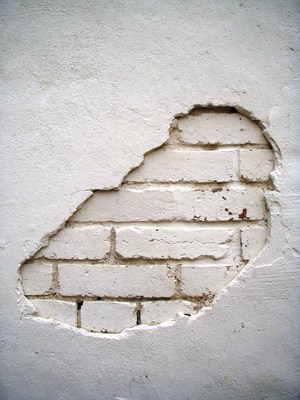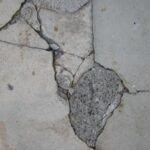Has your backyard swimming pool seen it’s better days? Do penetrated stains make it look as if the pool is always dirty? Is the plaster excessively worn or cracked? If so, you may be considering swimming pool rejuvenation measures in the form of a coat of fresh paint. Before you undertake a project of this magnitude, here are some of the things you should know about painting a gunite swimming pool. Here’s what you will learn:
- When, why, and how to paint your swimming pool
- Swimming pool preparation
- The acid wash
- Optimum painting procedures
- Refilling the pool and start-up procedures
Newly built or freshly plastered swimming pools have a relatively thick layer of plaster. This material provides the waterproofing characteristics of the pool that the more porous gunite cannot . It is designed to last up to 20 years. Over the course of time, wear and tear, stains, and mineral build-up will occur.
It is possible to revive the original luster of the pool a process called acid washing, which strips away the top layer of plaster along with the mineral build-up and stains. A normal pool can withstand several of these acid washings before the plaster becomes too thin to perform its intended purpose.
At this point, you have a choice. You may opt to undergo the expense of a new plastering job, or you may defer this expense for a few years and choose to paint the pool. Painting a swimming pool is only advised or necessary if it was previously painted, or to prolong the life of the pool for a few years before resurfacing. Since a good paint job will only last 2-7 years(depending on the quality of paint), it is not something you want to have to do very often.
Note: If you have black algae in the pool, it will have to be treated before draining the pool. Black algae roots itself in the plaster and then forms the black head for protection from chemicals. Removing the black heads with acid or scrubbing will leave the root to continue growing, even after painting. Ask your pool professional about the treatment process and follow the recommended procedures to ensure the black algae is eliminated before proceeding.
Prepare the pool for painting
Assuming everything else is in order, it is time to drain the pool. It is suggested that you rent a submersible pump and discharge the water to a storm drain or sewer access if local codes permit. Using the pool’s pump may risk damage to the equipment.
If you were brave enough to take on this project, you undoubtedly are a master at do-it-yourself home improvement. This would also be the perfect time to thoroughly clean the filter elements. A diatomaceous earth (DE) filter system will perform better and the grids will last longer if they are soaked in a 50-50 solution of muriatic acid and water. Cartridge elements require a special chemical soak available at the local pool store. A sand filter may require sand replacement for optimun performance.
The acid wash
After the pool is drained, the pool must be acid washed. This process etches the plaster to allow better paint adhesion. Be certain to wear proper safety clothing, rubber boots, particle mask, and rubber gloves. Sprinkle a 5 lb. container of soda ash around the main drain of the pool. This will serve to neutralize the acid. Mix a 50% solution of muriatic acid and water in a plastic bucket. Starting at the top of the pool wall and working down, brush the acid solution onto the wall. Allow the solution to remain on the surface for a few minutes, then rinse with plenty of fresh water. This rinse will flow toward the main drain where it will be neutralized by the soda ash, then it may be pumped out with the submersible pump. Continue with the same procedure until the entire surface of the pool has been treated.
After the acid wash, you will wash the walls with tri-sodium phosphate (TSP). This is a detergent that will neutralize the remaining acid on the surface and clean away any residual oil or dirt. Repair any cracks in the plaster. Allow the pool to dry completely. Depending on the outside temperature and humidity, this could take several days. Use masking tape to cover water inlets and the exposed skimmer parts.
Painting the pool
Swimming pool paint is most commonly a rubber-based coating and comes in a variety of colors. A quality paint job will last 3-5 years. You may alternately choose to use an epoxy paint which is more durable (5-7 years) but also more expensive. A less expensive water based paint for easier clean-up, but only lasts 2-3 years.
If the pool was previously painted, you must use the same type of paint to ensure proper adhesion. If you are uncertain of the paint type, take a paint chip to your local pool professional for identification. Follow the label directions for coverage and thinning the first coat of paint. The paint may be applied with a brush or roller, but is usually too thick for spraying.
The optimum time to paint is mid-morning when the outside temperature is 40-90 degrees. Avoid painting in direct sunlight if at all possible. Allow proper drying time (usually 24 hours) between coats. After the final coat, allow the paint to cure for 7-10 days. If it rains during this time, remove the standing water. Try to keep the paint as dry as possible. Use a leaf blower to assist in the drying process.
Refill and startup procedures
Now is the time to refill the pool. Once filled, it is time to get the filtering system operational. Reassemble the filter component and check the seals for wear and damage. Replace these if necessary.
The pump will likely need to be primed. Failure to do this could damage the seals and internal parts of the pump. To accomplish this, remove the pump lid and pour a gallon of water into the pump pot. Replace the lid as quickly as possible and start the pump. If the pump fails to start pumping water, repeat this process.
Diatomaceous earth filters will need to be recharged. Refer to the manufacturer’s specifications for the proper method.
Check with your swimming pool professional for the proper start-up chemicals. Typically a chlorine stabilizer will be needed if you use tablet chlorine. Be certain to adjust and maintain the pH and total alkalinity to the recommended levels.
Your newly refurbished pool is ready for use. You can now sit back and relax being confident that your pool will retain its luster and beauty for a few years giving you time to consider resurfacing the pool.




